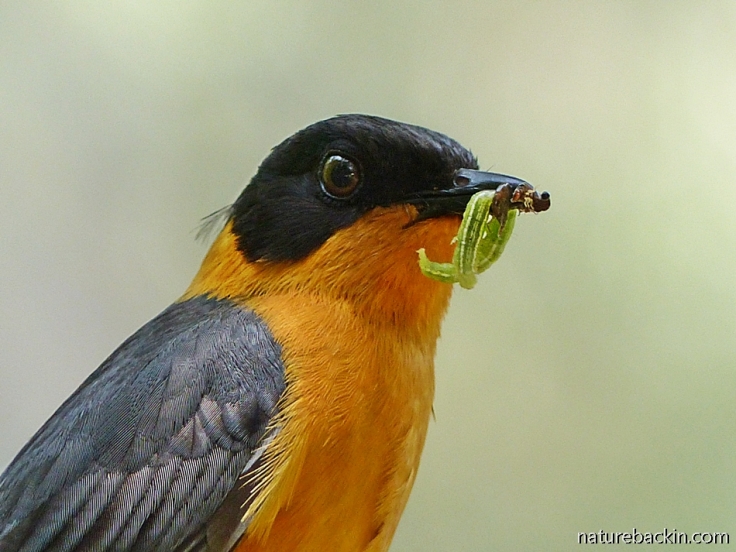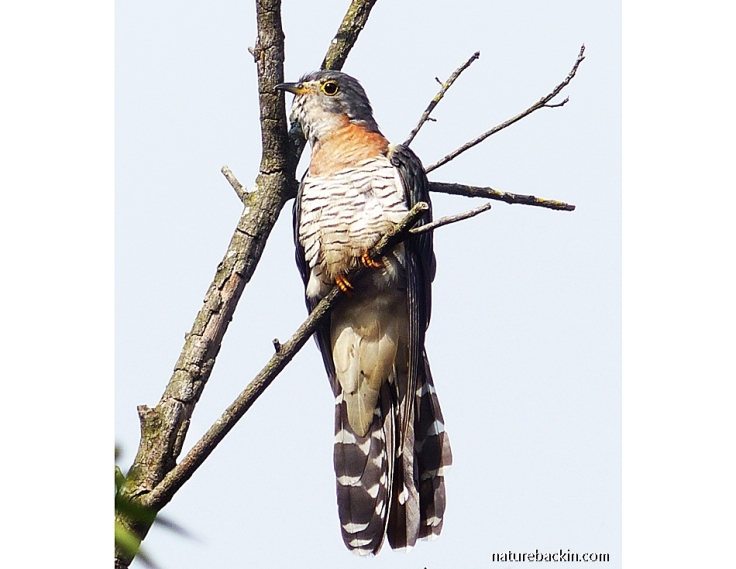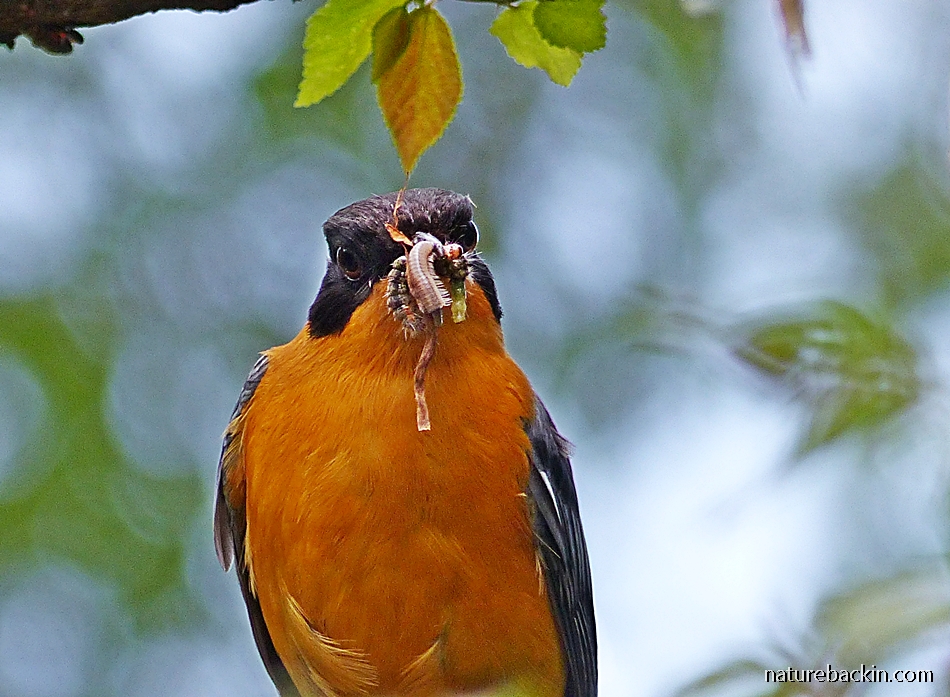Chorister Robin-chats are in permanent residence in our garden, but until now we have not known where they nest.
We found out rather unfortunately. My husband was extending roofing over a patio area attached to our garden cabin, when he inadvertently disturbed a nest on an existing roofing sheet under the eaves. Assuming the nest was old, he continued to put up an additional roofing sheet, but then we noticed that a Chorister Robin-chat was watching us with rapt attention.

We put two and two together and realised that the robin must have been in the process of completing the nest. So we left the nest under the eaves next to the new additional roofing sheet.
Though we continued to work on a fence in the vicinity, the robin, although very aware of us, calmly went to and from the nest, bringing additional nest-building material. It is the female Chorister Robin-chat who builds the nest. While she continued to be active at the nest we could hear her mate calling loudly while concealed in a neighbouring tree. Chorister Robin-chats have a variety of calls, including an impressive repertoire of copying the calls of other species.

After several days we heard the sound of baby birds in the nest and we observed both birds together as they maintained a busy schedule going to and from the nest frequently, taking turns feeding the babies
In the early morning and in the evening, the male would spend some time calling loudly. Interestingly, during this period he hardly ever copied the calls of other species unlike during the time when, unbeknown to us, the female had first started constructing the nest. At that time most evenings he would sing a playlist that including copying the calls of Crowned Eagles, Darkcapped Bulbuls, Emerald Cuckoos and others.

The assemblages of invertebrate prey that the parent Chorister Robin-chats brought to the nest were sometimes elaborate – and usually still alive

It had been fascinating to see how the birds can continue to collect prey while already holding one or two other quite sizeable creatures. Caterpillars and millipedes featured prominently on the menu

One of the parents, with a bill full of food, perching near the nest that is under the eaves and above one of the roofing sheets

The constant two-and-fro foraging must be exhausting

The parent Chorister Robin-chats glean prey in the trees and understorey vegetation. This parent appears to have scored two insect larvae

Chorister Robin-chats also forage on the ground, as this parent demonstrates, as it searches to add more items to the two larvae it already holds in its bill

Impressively, Chorister Robin-chats can also sing while holding prey in their bills. The female often pauses to sing softly prior to taking the food into the nest. In the early mornings the male is often calling and whistling loudly nearby
In this video, I record the Chorister Robin-chats calling, and show footage of the parents perching with prey items prior to taking them into the nest
All this activity has been going on for several weeks. We are starting to get anxious wondering when the fledglings will be able to navigate their way out of their very snug but perhaps unusually situated nest. Apparently, Chorister Robin-chat chicks remain in the nest on average for 14 days. After that both parents may continue to feed them for up to another six weeks.
So how long have the babies been in the nest? I first thought I heard the babies chirping in the nest 4 weeks ago, but I did not make a note as to when we first saw the parents taking food to the nest.

As Redchested-cuckoos (Piet-my-vrou) take about three weeks to fledge and there are Redchested-cuckoos very obviously around, calling loudly from nearby trees in fact, we have wondered if the parents weren’t perhaps feeding a baby cuckoo, as Redchested-cuckoos are known to parasitize Chorister Robin-chats (among others)
As we do not want to get close-up and risk disturbing the birds while they are nesting and it is too dark to see into the nest in its confined space from afar, we are not sure what is going on. But now I am starting to think I must have been mistaken when I first thought I heard baby birds in the nest.
So now we are recalculating and waiting with bated breath. We know for certain that the babies have been chirping in the nest for just over two weeks. I will keep you posted of any further developments, hoping we will be lucky enough to see the fledglings if and when they emerge from the nest.

And to close, exactly four weeks ago, I photographed one of the Chorister Robin-chats near the nest. In a series of photos I took that morning, only a few shots showed this mantle of soft orange-fringed feathers on its back that can be clearly seen in the above photo. I have not seen these feathers showing again, nor have I seen them in any other photos of Chorister Robin-chats that I can find. I can only guess that usually these soft feathers are concealed under the folded-back wings?

Source: Roberts VII Multimedia PC Edition. 1997-2016 Southern African Birding. For details go to http://www.sabirding.co.za/roberts7/portal.html
Posted by Carol









November 6, 2019 at 5:32 pm
Well done. I have a pair of Cape Robins nesting in my garden. Lovely birds.
LikeLiked by 1 person
November 8, 2019 at 7:02 pm
Thanks Nick. Cape Robins are lovely too. We also have them here and although I have seen one feeding a a very demanding youngster on the ground I have not yet seen where they nest.
LikeLike
November 28, 2018 at 9:56 am
Carol this is such a lovely blog, so much information and stunning observation and photos! I so enjoy your view on nature, thank you!
LikeLiked by 1 person
November 29, 2018 at 6:06 am
Thanks Christeen. I really appreciate the feedback and I enjoy sharing my ‘discoveries’.
LikeLiked by 1 person
November 25, 2018 at 4:33 pm
Marvelous post, Carol.
We don’t have these beauties up here – at least I’ve never seen one.
Your photos and the video in this set are superb.
Well done!
LikeLiked by 1 person
November 26, 2018 at 7:36 am
Thanks so much Ark. I understand that Chorister Robin-chats are adapted to forest and woodland habitats and live in or proximate to areas where the tree canopy is closed. I also read that though they are listed as an “IUCN Red List least concern species”, sadly their numbers are declining as their habitat declines. (Can’t help adding that “declines” is such a gentle word for what is so often a brutal process!)
LikeLiked by 1 person
November 26, 2018 at 9:28 am
Then all the more reason to cherish and if possible encourage them at your spot.
LikeLiked by 1 person
November 26, 2018 at 9:20 pm
I think suburban spaces definitely have a role to play.
LikeLike
November 23, 2018 at 5:26 am
What amazing photographs of these lovely birds. You are lucky to have these lovelies so near and so tolerant. I await news of the chicks.
The video was charming. So lovely to see these birds up close. Nice to think they keep the insects in check, too. 😉
LikeLiked by 1 person
November 23, 2018 at 11:05 am
Thanks Gunta. It is a privilege to have the birds confidently doing what they do. They have not run out of insects and other prey yet, but I think some of the foraging trips are a bit further afield as time goes on.
LikeLiked by 1 person
November 23, 2018 at 4:59 am
Terrific photos. I love the details of the tasty morsels for the youngsters. I look forward to hearing how this turns out.
LikeLiked by 1 person
November 23, 2018 at 11:02 am
Thanks Graham. I found the lined-up collections of food items really amazing. Hope to be able to bring an update re the babies and a happy outcome!
LikeLiked by 1 person
November 27, 2018 at 4:42 am
I hope so too.
LikeLiked by 1 person
November 23, 2018 at 4:40 am
What a joy to read! This is a marvellous record of the Chorister Robin-chats – beautiful photographs and an interesting video to boot. I see your crossberries have also come into flower.
LikeLiked by 1 person
November 23, 2018 at 11:01 am
Thanks Anne. Glad you like the video – it was a challenge to try to get both sound and vision! The crossberries are flowering very well this year.
LikeLike
November 23, 2018 at 2:12 am
Beautiful photographs, Carol, and what an amazing opportunity to watch their breeding cycle so closely!
LikeLiked by 1 person
November 23, 2018 at 10:58 am
Thanks so much. Yes it is fascinating to watch the parents and appreciate how busy they are. I am becoming anxious about how many threats newly fledged baby birds potentially face. Even in the nest, predators can find them, though I think they are relatively safe where they are. No wonder they seem reluctant to leave!
LikeLiked by 1 person
November 22, 2018 at 11:32 pm
Superb photos! What excellent providers these two are.
LikeLiked by 1 person
November 23, 2018 at 10:54 am
Thanks Belinda. They sure are, and working very hard.
LikeLiked by 1 person
November 22, 2018 at 10:45 pm
Such a stunning bird and great captures!
LikeLiked by 1 person
November 23, 2018 at 10:54 am
Thanks Sandy. It is lovely to have them so confiding.
LikeLiked by 1 person
November 23, 2018 at 3:29 pm
Definitely.
LikeLiked by 1 person
November 22, 2018 at 9:39 pm
A delightful bird-such smart colouring. I’m glad they stayed on after the building disturbance and let you enjoy watching the young ones develop. I enjoyed the video too.
LikeLiked by 1 person
November 23, 2018 at 10:46 am
Thanks so much Jane. We are trying to keep an eye open to see if the nestlings leave the nest, while also trying to give them enough “space” to do so undisturbed. It is remarkable that the birds coped with the disturbance and continued with their project. The parents approach us quite confidently at times while they are foraging, which is very sweet.
LikeLiked by 1 person
November 22, 2018 at 9:05 pm
The charming name alone was enough to draw me into this post. What a delightful addition to your garden residents. I’m amazed that they stayed after their building activity was disturbed. They must know good neighbours when they see them. A really lovely video too.
LikeLiked by 1 person
November 23, 2018 at 10:38 am
We were surprised to that the robin-chat resumed her nest building, and we were very relieved too, as we had felt really bad about disturbing the nest. The pair seem to have taken us into their confidence. Usually these birds are quite reticent, apart from calling loudly that is.
LikeLiked by 1 person
November 24, 2018 at 9:25 am
Perceptive as well as charming then!
LikeLiked by 1 person
November 26, 2018 at 7:27 am
🙂
LikeLiked by 1 person
November 22, 2018 at 8:24 pm
Superb photos and I loved the video, Carol. Such a lovely bird and call to accompany you in the garden!
LikeLiked by 1 person
November 23, 2018 at 10:35 am
Thanks Eliza. There was a second pair in the garden today, and much calling going on. It is unusually chilly today for this time of the year, and probably not a good day for comfort-seeking babies to leave the nest!
LikeLiked by 1 person
November 22, 2018 at 8:16 pm
What a beauty!
LikeLiked by 1 person
November 22, 2018 at 8:19 pm
Thanks Janet. All our Robin-chats are appealing but I think that the Chorister Robin-chats have a special kind of glamour, even with a mouthful of creepy-crawlies 🙂
LikeLike